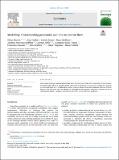Files in this item
Modelling : understanding pandemics and how to control them
Item metadata
| dc.contributor.author | Marion, Glenn | |
| dc.contributor.author | Hadley, Liza | |
| dc.contributor.author | Isham, Valerie | |
| dc.contributor.author | Mollison, Denis | |
| dc.contributor.author | Panovska-Griffiths, Jasmina | |
| dc.contributor.author | Pellis, Lorenzo | |
| dc.contributor.author | Tomba, Gianpaolo Scalia | |
| dc.contributor.author | Scarabel, Francesca | |
| dc.contributor.author | Swallow, Ben | |
| dc.contributor.author | Trapman, Pieter | |
| dc.contributor.author | Villela, Daniel | |
| dc.date.accessioned | 2022-09-28T11:30:19Z | |
| dc.date.available | 2022-09-28T11:30:19Z | |
| dc.date.issued | 2022-06-06 | |
| dc.identifier | 281140563 | |
| dc.identifier | 36236e74-6eaa-415d-9366-f92b5f229a2c | |
| dc.identifier | 000810717200008 | |
| dc.identifier | 85131903235 | |
| dc.identifier | 35679714 | |
| dc.identifier.citation | Marion , G , Hadley , L , Isham , V , Mollison , D , Panovska-Griffiths , J , Pellis , L , Tomba , G S , Scarabel , F , Swallow , B , Trapman , P & Villela , D 2022 , ' Modelling : understanding pandemics and how to control them ' , Epidemics , vol. 39 , 100588 . https://doi.org/10.1016/j.epidem.2022.100588 | en |
| dc.identifier.issn | 1755-4365 | |
| dc.identifier.other | ORCID: /0000-0002-0227-2160/work/118411966 | |
| dc.identifier.uri | https://hdl.handle.net/10023/26085 | |
| dc.description | Funding: This work was supported by Engineering and Physical Sciences Research Council (EPSRC) grant no. EP/R014604/1. G.M. is supported by the Scottish Government's Rural and Environment Science and Analytical Services Division (RESAS). L.H. is funded by the Wellcome Trust, UK (block grant no. RG92770). L.P. is funded by the Wellcome Trust, UK and the Royal Society, UK (grant no. 202562/Z/16/Z). L.P. and F.S. are supported by the UK Research and Innovation (UKRI) through the JUNIPER modelling consortium (grant no. MR/V038613/1). L.P. is also supported by The Alan Turing Institute for Data Science and Artificial Intelligence. Daniel Villela is a fellow from National Council for Scientific and Technological Development, Brazil (Ref. 309569/2019–2, 441057/2020–9). JPG's work is supported by funding from the UK Health Security Agency and the UK Department of Health and Social Care. | en |
| dc.description.abstract | New disease challenges, societal demands and better or novel types of data, drive innovations in the structure, formulation and analysis of epidemic models. Innovations in modelling can lead to new insights into epidemic processes and better use of available data, yielding improved disease control and stimulating collection of better data and new data types. Here we identify key challenges for the structure, formulation, analysis and use of mathematical models of pathogen transmission relevant to current and future pandemics. | |
| dc.format.extent | 13 | |
| dc.format.extent | 2928651 | |
| dc.language.iso | eng | |
| dc.relation.ispartof | Epidemics | en |
| dc.subject | Infectious disease models | en |
| dc.subject | Behaviour and multi-scale transmission dynamics | en |
| dc.subject | Within, host dynamics | en |
| dc.subject | Pathogen dynamics | en |
| dc.subject | Value of information studies | en |
| dc.subject | RA0421 Public health. Hygiene. Preventive Medicine | en |
| dc.subject | QA75 Electronic computers. Computer science | en |
| dc.subject | T-NDAS | en |
| dc.subject | SDG 3 - Good Health and Well-being | en |
| dc.subject | MCC | en |
| dc.subject.lcc | RA0421 | en |
| dc.subject.lcc | QA75 | en |
| dc.title | Modelling : understanding pandemics and how to control them | en |
| dc.type | Journal article | en |
| dc.contributor.institution | University of St Andrews. School of Mathematics and Statistics | en |
| dc.contributor.institution | University of St Andrews. Centre for Research into Ecological & Environmental Modelling | en |
| dc.identifier.doi | 10.1016/j.epidem.2022.100588 | |
| dc.description.status | Peer reviewed | en |
This item appears in the following Collection(s)
Items in the St Andrews Research Repository are protected by copyright, with all rights reserved, unless otherwise indicated.

